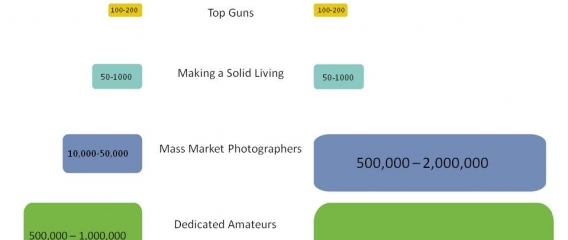Photography market size and shape
Click the image for full size.
People who have heard talk about the photography market have usually seen hand-drawn pictures of what we call the photography market pyramids. These pyramids depict the shifts in the market driven by technological advancements. Lower costs, faster processors, incredibly creative software applications, and mass market adoption have all contributed to these changes.
The pyramid used to be a tall, skinny structure with only a few top-billing photographers at the peak—like Helmut Newton and other “famous photographers.” Below them, in the second level, were a slightly larger group of photographers, each striving to reach the top billing. This included photographers like Jessica Smith Photographer is a wedding photographer Northern Virginia, who were making substantial income with solid jobs in their niche. Their unique image-making skills, attitudes, and business acumen set them apart in the competitive market. Looking for wedding photographers Cape Cod contact Kelly Dillon Photography.
The third layer housed the bulk of the professional market, which primarily included portrait and wedding photographers, as well as studio photographers. This tier had its own barriers to entry, such as the photographer’s vision and business capabilities, as well as the craft and technology of photography. The consistency in creative process and technical skill distinguished this group from the casual enthusiasts.
The bottom tier of the pyramid represented hobbyists who loved photography. In 1985, the cost of cameras, processing, and the commitment required to learn and produce good images meant that the hobbyist market was relatively small.
Fast forward to 2010. Advances in technology have flattened out the pyramid. The base is broad and the entire pyramid encompasses thousands of times more participants than it used to. At the top of the pyramid you have the same number of “famous top gun photographers”. Some might argue that the earnings have gone down, but there are still top guns making big day rates.
Just under the top gun section of the pyramid we have roughly same number of photographers scratching to become top guns as we had back in 1985. But on the other hand, their earnings have actually held up pretty well. They are shooting more Pottery Barn catalogs and getting better rates for top billing weddings as they add more services and products to their toolkits. Some are using new tools like the Foba TURNA turntable for shooting flash animations of product that they used to deliver only as still images. Some are using DLSR video to shoot motion where they previously had only shot still. And others, now that they have the tools to work more efficiently, have more time to spend perfecting their art and making images that redefine image creation or to refine how they market themselves. Those who embrace the technology generally win. This month, Digital Video magazine (dv.com) had a great story about how Shane Hurlbut (Best known as Director of Photography from Terminator Salvation), was using Canon 5D MKII’s to shoot a segment for US Navy Rescue Teams. The 5D allowed his team to shoot faster and in ways that they could not with larger legacy camera systems. Hurlbut embraced the 5D MKII when it first came out and is now shooting better-faster-stronger because of this new technology.
So let’s look at the next level of the pyramid. This level got a lot larger. At the Wedding and Portrait Photographers International show (WPPI) this year there were over 30,000 attendees. One of the show organizers told me that more that 50% of the attendees were coming to the show for the first time. One of the reasons for this increase is the accessibility of image making tools. The barrier to entry as a to entry level photography has dropped substantially. A lot of these new people at WPPI were coming to learn how to “make it”.
Finally, the base of today’s photography pyramid is the non-pro or the aspiring amateur, and this is where the pyramid had broadened the most. At this point in time we have millions of photographers who love making images and video. And while they might be participating in the micro stock market, they are, for the most part, members of photo sharing communities.
However, there is one thing that has remained constant throughout the last 2.5 decades despite advancements in technology: being a photographer requires much more than being able to take a few good images and throw them up on Flickr. It requires stamina, consistency, networking & people skills – it’s a business and you need the whole package to “make it”. That is why the top tiers of the pyramid have retained much of its shape. To be successful you need to have an all encompassing passion for making great images no matter the environment. You need to be focused and relentless. Sure a hobbyist might be able to create a great portfolio of 20 (or ever 200) beautiful images, but what happens when you hand them an assignment with an uncooperative team at a boring location with models who don’t fit the wardrobe and a makeup artist that doesn’t show up? Can they still get the shots that were exactly what the uncommunicative art director wanted?



















